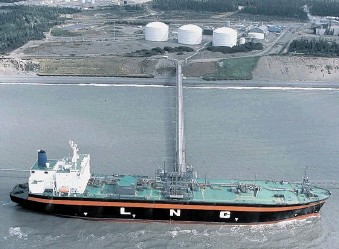
Alaska’s three largest operators have joined forces to propose a major Alaska liquefied natural gas (LNG) project with the objective of offering supply North Slope natural gas to Asian markets.
ConocoPhillips, ExxonMobil, and BP have submitted the project to Alaska Governor Sean Parnell. They have teamed with Canadian pipeline company TransCanada to develop the project.
The proposal submitted to Parnell said: “We are encouraged by the synergies and efficiencies identified by our integrated team. While good progress has been made, significant environmental, regulatory, engineering, and commercial work remains to reach upcoming decisions to bring North Slope gas to market.”
The proposal is, in essence, a solution to the long-running issue of what to do with the Slope’s huge gas reserves which have, until now, been regarded as “stranded” . . . all 35trillion cu ft of it.
However, by building a gas gathering system and export pipeline and liquefaction plant on the coast, it would be possible to export large quantities of LNG to global markets, in particular Asia-Pacific consumers.
Initial output from the LNG plant would be in the range 15-18million tonnes a year from three liquefaction trains that would be fed with North Slope gas via an 800-mile north-to-south pipeline with a capacity of 3-3.5billion cu ft per day.
“This opportunity is challenged by its cost, scale, long project lead times, and reliance upon interdependent oil and gas operations with declining production,” the companies say in their proposal.
“A healthy, long-term oil business, underpinned by a competitive fiscal framework and LNG project fiscal terms is required to monetise North Slope natural gas resources.”
The project will, however, require both federal and state approval, which could take a year or more, if granted.
Meanwhile, Alaskans are no strangers to producing gas for the LNG market. The pioneering Kenai LNG plant began operating in 1969, after the nearby North Cook Inlet Gas Field was discovered in 1962. Nearly all LNG produced at the plant was sold via contracts with two Japanese utilities.
According to ConocoPhillips, while new US LNG export projects are underway, the Kenai LNG facility has for more than 40 years been the only American LNG export facility.
However, early last year, ConocoPhillips announced that it would be ceasing LNG exports from Kenai later in the year. It would then mothball the plant for potential future use.
The Kenai facility has historically also played a key role in serving the natural gas needs in South-central Alaska by providing critical additional deliverability to the local market during peak demand and emergency situations.
In February 2011, the Alaskan state Capitol house speaker, Mike Chenault said: “It’s a sad day when we shut down an export facility knowing that we have 35 known (trillion cubic feet) of gas on the North Slope that’s just 800 miles away and one of the things we’re looking at is importing LNG from some foreign country.
ConocoPhillips has since back-tracked on its decision. In June this year, Kenai was re-opened, apparently temporarily and pending re-evaluation of the plant’s future. Now, with the huge Alaska Slope LNG project gestating, it seems that a new chapter is about to open for the US’s first and only active liquefied gas process/export terminal.